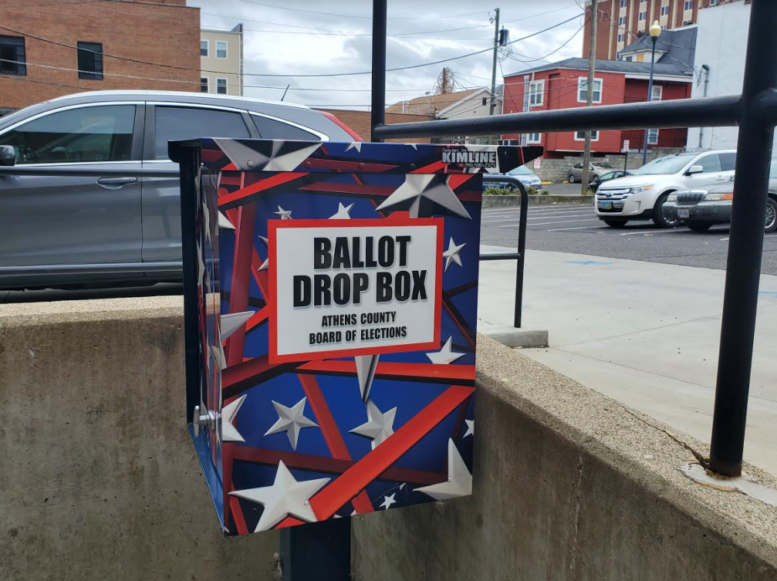BY SUSAN TEBBEN
Voting for the races in the May 3 primary is still going on, despite uncertainty concerning legislative maps.
The primary ballot for May will include races for governor, attorney general, auditor of state, secretary of state, treasurer of state, Ohio Supreme Court and congressional races for U.S. Senate and U.S. House of Representatives, along with judicial and municipal candidates.
The only races left off the May ballot are the legislative races for the Ohio Senate and Ohio House of Representatives, along with members of the state Central Committee. They will be on a second primary, potentially later this summer.
Ohio Secretary of State Frank LaRose made note of this in a recent press release regarding the rejection of legislative maps by the Ohio Supreme Court, attempting to address the confusion of having two primary elections.
“The court’s latest ruling has no impact on that (May 3 primary) election at all, and contests for statewide, congressional and local offices and issues will proceed as scheduled,” LaRose said. “This ruling only impacts state legislative and political party central committee contests, which have yet to be scheduled.”
Wednesday is a significant date in the legislative redistricting issue, which has been going on since last September. A U.S. District Court considering a lawsuit to force a decision on legislative maps asked the secretary of state’s office when maps would need to be in place to run a primary on Aug. 2. The office gave April 20 as the last day that option would be viable for a ballot of legislative races to be ready for an Aug. 2 primary.
The date folds in candidacy filing deadlines, time for county boards of election to reprogram voting machines and adjust district maps to help voters identify for whom they may be voting, along with windows for early voting.
Wednesday will now go by without a map to consider, after a 4-3 majority of the Ohio Supreme Court ruled the fourth attempt at legislative maps was unconstitutional, just a mere tweak of a third map they’d rejected as unduly partisan.
In the last rejection by the state supreme court, the majority justices questioned why Aug. 2 is the “last available date for a primary election in Ohio.”
“We note that several states will have primary elections on Aug. 16, 2022, or later, including four states that will have their primary elections in September,” the court wrote in its April 14 decision.
Secretary of State Frank LaRose said this statement “indicates a shocking and clear ignorance of Ohio law.”
Ohio’s elections work on 90-day calendars, LaRose told Ohio Redistricting Commission members in a Tuesday letter. Sixty of those days are used to prepare for the election, and 30 days are made up of post-election audits and certifications.
“If you apply the 90-day calendar established in state law to the available dates between May 3 … and November 8 (the general election), it takes us to – you guessed it – August 2,” LaRose wrote to legislative leaders and statewide officials on the commission.
That date standing in state law as a fall-back date in case special elections are needed. But any point beyond that date encroaches on the 90-day calendar for the general election, the state’s elections chief said.
LaRose said election requirements in the state set the filing deadline for nonpartisan races in the general election for Aug. 8.
“To be clear, any primary held after August 2 would directly conflict with the statutorily required deadlines of the General Election,” LaRose wrote in a statement.
The General Assembly could change those statutory requirements, just as they could change the primary dates, but legislative leaders have made no moves to do so, claiming a lack of interest from the legislature as a whole.
The Ohio Redistricting Commission has until May 6 to come up with new maps for the Statehouse districts, and so far has made no movement to start the process again. The Democratic members of the commission, state Sen. Vernon Sykes and House Minority Leader Allison Russo, sent a letter to commission members asking that the process be restarted as soon as possible.
“We believe that the commission should reconvene in the next few days and rehire the independent mapmakers who were utilized in the last mapmaking round,” the letter stated.
It’s unclear what the federal court will do now that the April 20 date will pass by without a constitutional map, but they have maintained throughout the process of litigating the lawsuit that they would only intervene in the state process if absolutely necessary. They have already decided against intervention twice since the lawsuit was filed, once regarding legislative maps and once related to congressional redistricting.
LaRose, however, seems to putting his money on the federal court, after singling out Ohio Supreme Court Justice Jennifer Brunner — a former state secretary of state who is running for chief justice — as being a part of a court majority that “ignores, and in fact, attempts to rewrite the key requirements of election administration literally spelled out in the law.”
“We will reinforce those statutory timelines to the federal court and hope that constitutional convictions prevail,” LaRose wrote in a statement.
Data released by the Ohio Secretary of State’s office on Tuesday noted 125,118 absentee ballots had been requested and nearly 45,000 votes have been cast in advance of the May 3 primary.
Early voting is in its third week, and continues until May 2.
***
More headlines from Ohio Capital Journal:




